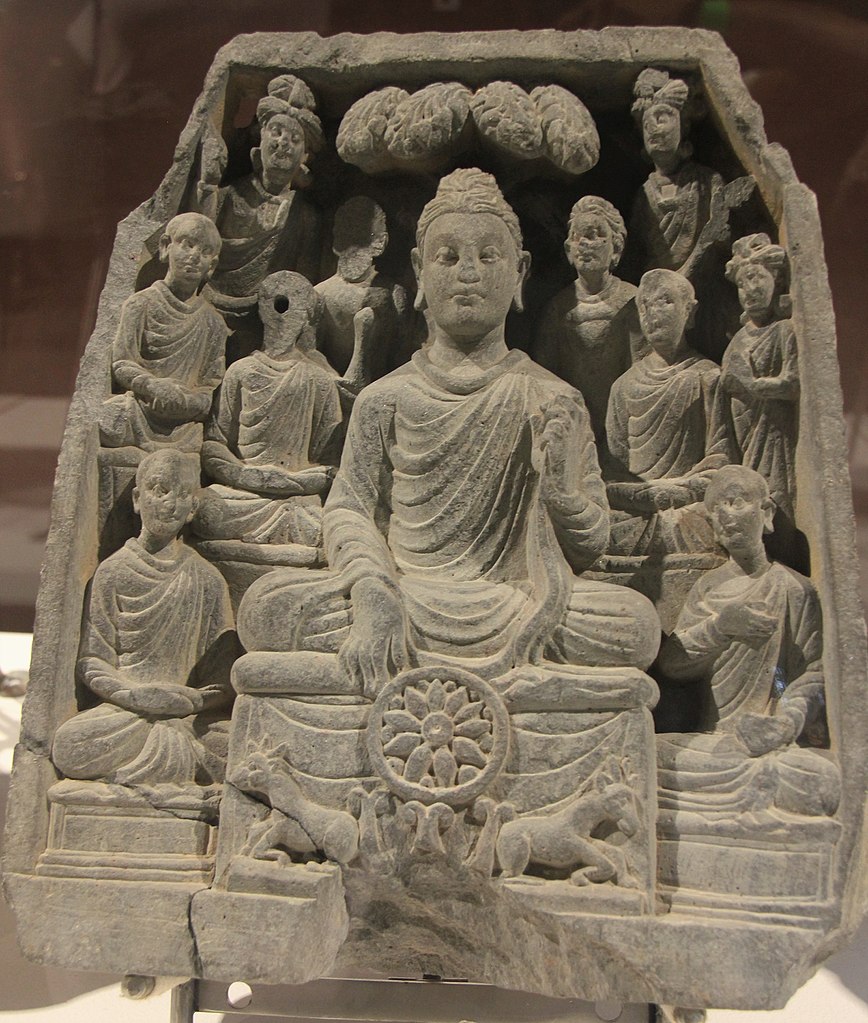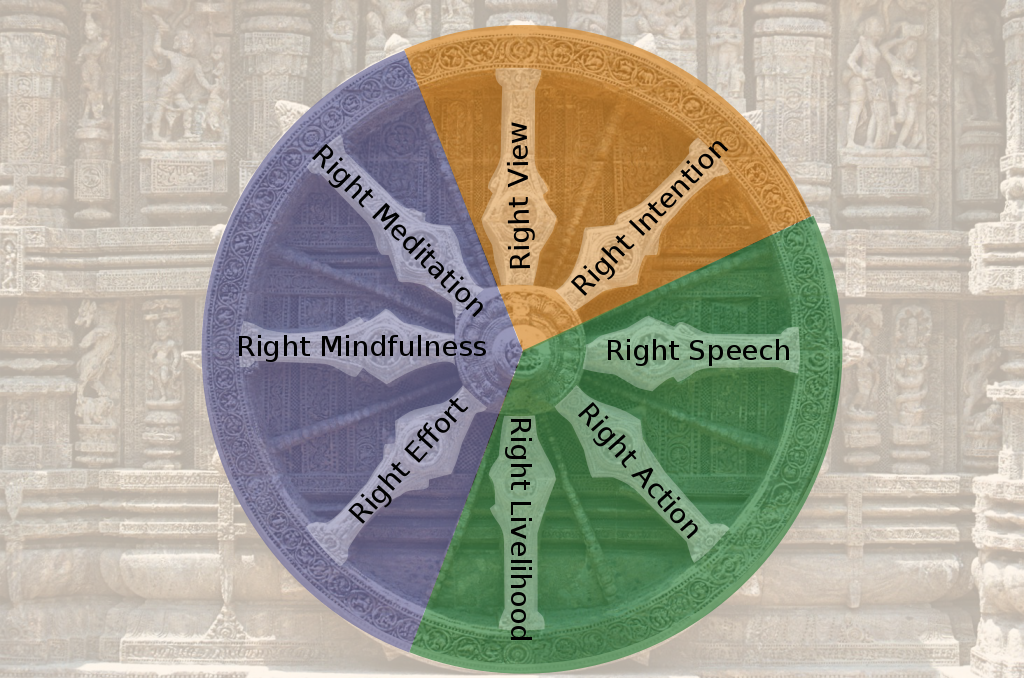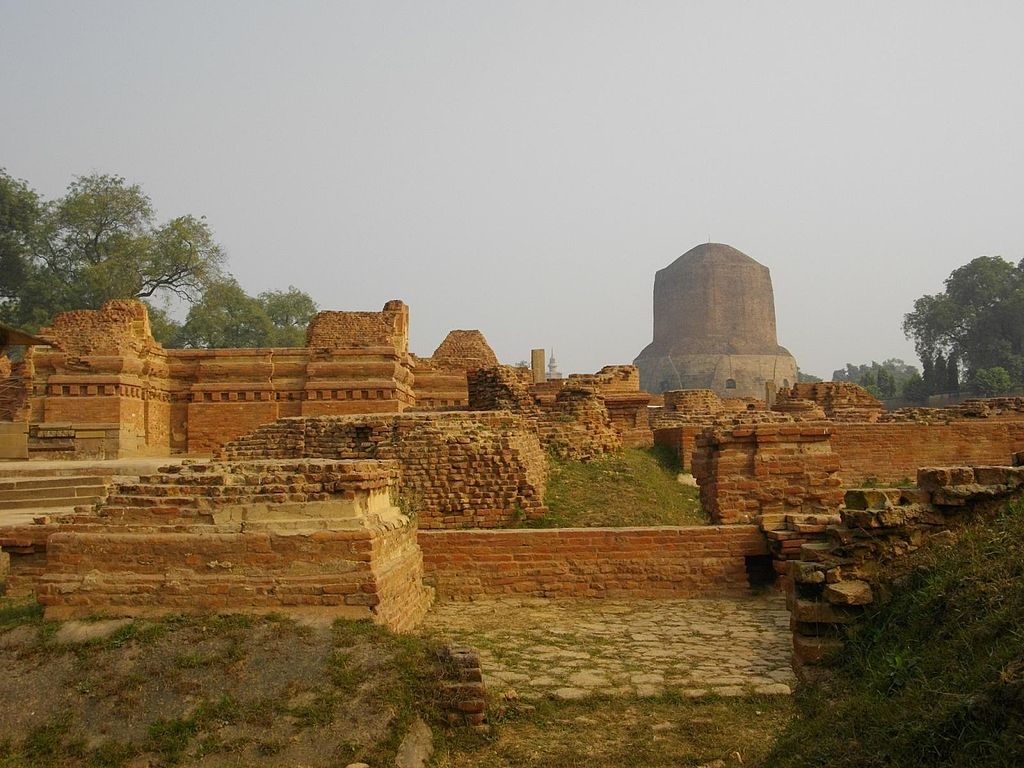The way to stilling, direct knowledge, self-awakening, and unbinding
The First Sermon

The First Sermon the Buddha is said to have given in Sarnath near Varanasi begins with the doctrine of the Middle Way. The Buddha is addressing the five companions who had shared his quest, but had left him when he had broken his fast.
“There are these two extremes that are not to be indulged in by one who has gone forth. Which two? That which is devoted to sensual pleasure in connection with sensuality: base, vulgar, common, ignoble, unprofitable; and that which is devoted to self-affliction: painful, ignoble, unprofitable. Avoiding both of these extremes, the middle way realized by the Tathāgata—producing vision, producing knowledge—leads to stilling, to direct knowledge, to self-awakening, to unbinding.

And what is the middle way realized by the Tathāgata that—producing vision, producing knowledge—leads to stilling, to direct knowledge, to self-awakening, to unbinding? Precisely this noble eightfold path: right view, right resolve, right speech, right action, right livelihood, right effort, right mindfulness, right concentration. This is the middle way realized by the Tathāgata that—producing vision, producing knowledge—leads to stilling, to direct knowledge, to self-awakening, to unbinding.”
It is only after expounding his views on the Middle Way that the Buddha came to what is regarded as the gist of the Buddhist teaching – the well-known formula of the Four Noble Truths.
Taken as a summary of the Buddha’s teachings, the First Sermon presents the Middle Way as the starting point, the Four Noble Truths as unpacking the general causal principle – craving is the cause of suffering; if craving ceases, suffering will cease too – and the Noble Eightfold Path as providing the details of a path of practice that practitioners are to follow in order to overcome craving.
Scholars of early Buddhism have not, however, given as much attention to the Middle Way as they have to the Eightfold Path, co-dependent origination, the Four Noble Truths, or even the Twelve Nidanas. It may be because a path of moderation between excessive indulgence and excessive deprivation is easily grasped as a commonsensical way to live one’s life. So, it could not be the revolutionary teaching the Buddha is credited to have brought to us.
Aristotle’s Golden Middle Way and Confucius’ Doctrine of the Mean
In fact, similar teachings are found in the works of at least two other great thinkers, namely, Aristotle and Confucius. In ancient Greece, Aristotle advocated “the Golden Middle Way” as a path between the two extremes of excess and deficiency. In ancient China, Confucius taught the Doctrine of the Mean, understood as a cultivation of a mental state of equilibrium, also insisting that one conforms to one’s status in the world, apparently implying that this status was “natural,” and had to be adhered to.
Even though the two doctrines originated in drastically different cultures, both represented normative efforts to rein in social unrest, and establish a metaphysical foundation for order. Even Confucius, who lived in a non-metaphysical culture, where reality has been seen as change, a flow of life energy manifesting as ever changing forms, was in fact trying to put some order into the “big blooming buzzing confusion,” as William James once called it. This was the goal of Confucius’ “Rectification of Names” described as “making words correspond to reality.” Confucius’ entire project was to formalise all aspects of life, a wide-ranging reification programme, which is the exact opposite of what the Buddha was seeking. Given that Aristotle was Alexander the Great’s personal teacher, he too was probably motivated by socio-political reasons when he elaborated the principles of reason, to be used to sort out what is and what is not, and set up a logical and balanced order of things.
The extremes of self-indulgence and self-mortification
Presented as it was at the beginning of the Buddha’s First Sermon, which, according to tradition, was delivered to the five ascetics who had deserted him when he had discontinued his fast, the teaching about the Middle Way appears to take aim at the extreme of self-mortification. It could be taken primarily as a warning against the reliance on extreme “austerities” to attain cessation of suffering through release from reincarnation, which was common practice especially among the Jains. Because self-indulgence is universally taken to be product of ego-centredness, and what fuels attachment and dependence upon the pleasures of life, many are those who believe that the practice of its opposite – self-mortification – will liberate them from such attachment and dependence. The Buddha’s argument is that it is not so. Ascetic practices can also be prompted by pride, the wish to “be more” and therefore lead to attachment. Even when practitioners of such practices are not involved in a deliberate display of “ascetic feats,” and see themselves simply as serious seekers, they are at risk of becoming attached to the performance of the practice instead of keeping their eyes on the goal of realising no-self.
The Buddha’s Middle Way was not worked out as a response to socio-political concerns, but rather as a psycho-spiritual discipline to avoid attachment. It was a practical teaching to keep practitioners from falling into the traps set up by the ego. The parable of the lute presents this avoidance of extremes as being not too tight and not too loose: either way the sound will be unsatisfactory. The same is to be applied to one’s practice. Self-mortification requires an excessive exercise of will power, which causes as much attachment as self-indulgence does through its obsession with pleasures.
The extremes of eternalism and annihilationism
On the basis of texts such as the Majjhima Nikaya, including discourses attributed to the Buddha and his chief disciples, Peter Harvey writes: “In the early texts, the notion is seen in the idea of Conditioned Arising [co-dependent origination] as avoiding the extremes of both “eternalism” and “annihilationism” as regards the fate of a person after death.” Specifically, it refers to the process of karmic transmission from one life to another: “At death, the momentum set up by constructing activities (and craving) is not cut off, but impels the evolving flux of consciousness to spill over beyond one life and help spark off another … No unchanging ‘being’ passes over from one life to another, but the death of a being leads to the continuation of the life process in another context, like the lighting of one lamp from another … The ‘latter’ being is a continuation, or evolute of the ‘earlier’ one on which he is causally dependent. They are linked by the flux of consciousness and the accompanying seed of karmic results, so that the character of one is a development of the character of the ‘other’.”
The doctrine of Conditioned Arising provides a middle way avoiding the extreme of eternalism (the self as an unchanging “eternal” essence) and annihilationism (the total annihilation of the deceased person). Conditioned Arising here is taken in the sense of a serial chain of causation, as it was in the Twelve Nidanas. No substantial “being,” as it were, leaps from one body to another. Instead it is an energy, life energy tainted by craving. Karmic residues are “seeds,” that is, compacted energy, and the image of lighting a lamp from another is perfect. Another image used is that of a billiard ball hitting another and transmitting its energy to it.
Harvey adds that Conditioned Arising “presents a “middle” way of understanding that echoes the Buddhist path as a “middle way”of practice. This idea was to be greatly influential on later forms of Buddhism – such as the Madhyamika, or “Middle Way” school – all of which sought to best express the true “middle” way of understanding reality.”
Sources
First sermon of the Buddha – https://www.dhammatalks.org/suttas/SN/SN56_11.html
Peter Harvey – An Introduction to Buddhism: Teachings, History and Practice (2013)

